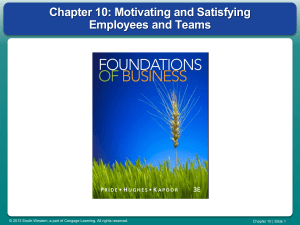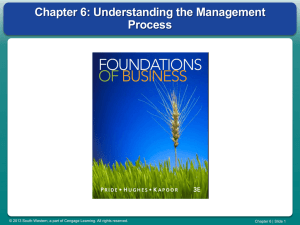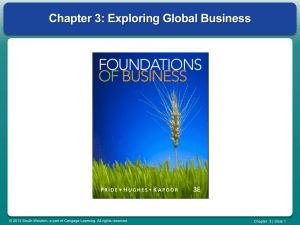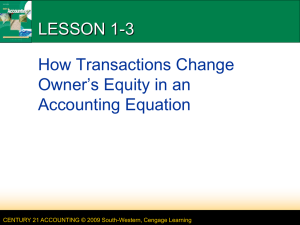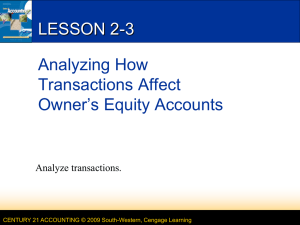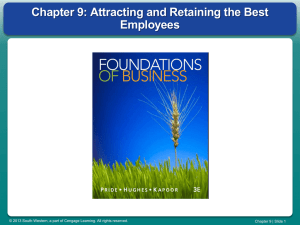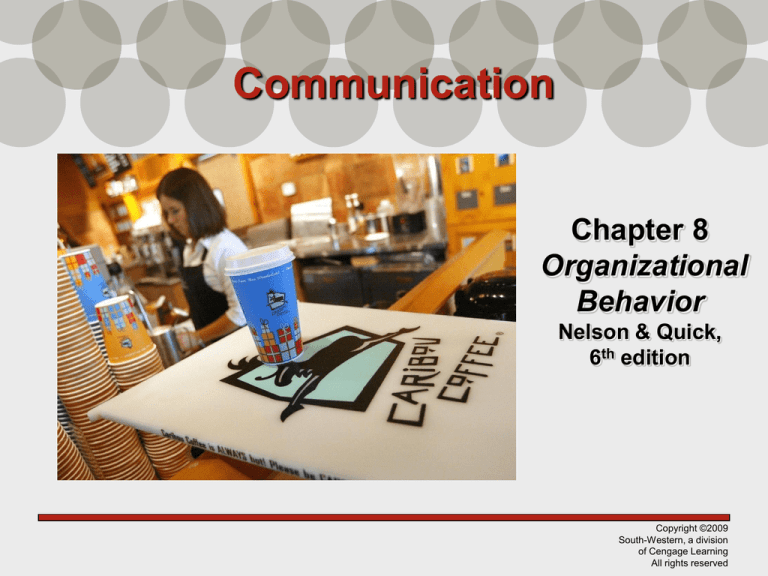
Communication
Chapter 8
Organizational
Behavior
Nelson & Quick,
6th edition
Copyright ©2009
South-Western, a division
of Cengage Learning
All rights reserved
Communication
Communication - the evoking of a shared or
common meaning in another person
Interpersonal Communication - communication
between two or more people in an organization
Communicator - the person originating the
message
Receiver - the person receiving a message
Perceptual Screen - a window through which we
interact with people that influences the quality,
accuracy, and clarity of the communication
Copyright ©2009
South-Western, a division
of Cengage Learning
All rights reserved
Communication
Message - the thoughts and feelings
that the communicator is attempting to
elicit in the receiver
Feedback Loop - the pathway that
completes two-way communication
Language - the words, their
pronunciation, and the methods of
combining them used & understood by
a group of people
Copyright ©2009
South-Western, a division
of Cengage Learning
All rights reserved
Communication
Data - uninterrupted and unanalyzed facts
Information - data that have been
interpreted, analyzed, & and have
meaning to some user
Richness - the ability of a medium or
channel to elicit or evoke meaning in the
receiver
Copyright ©2009
South-Western, a division
of Cengage Learning
All rights reserved
Basic Interpersonal
Communication Model
Feedback
/
/
/
/
/
/
/
/
/
Communicator
/
/
/
/
/
/
/
/
/
Message
• Context
• Affect
Perceptual screens
/
/
/
/
/
/
/
/
/
Receiver
/
/
/
/
/
/
/
/
/
Event
X
Perceptual screens
Influence message quality, accuracy, clarity
Include age, gender, values, beliefs, culture,
experiences, needs
Copyright ©2009
South-Western, a division
of Cengage Learning
All rights reserved
Communication Media:
Information Richness
& Data Capacity
Information
Richness
Data Capacity
Face-to-face discussion
Highest
Lowest
Telephone
High
Low
Electronic mail
Moderate
Moderate
Individualized letter
Moderate
Moderate
Personalized note or
memo
Moderate
Moderate
Formal written report
Low
High
Flyer or bulletin
Low
High
Formal numeric report
Lowest
Highest
Medium
SOURCE: Created by E. A. Gerloff from “Information Richness: A New Approach to Managerial Behavior and Organizational
Design” by Richard L. Dalt and R. H. Lengel in Research in Organizational Behavior 6 (1984); 191-233. Reprinted by
permission of JAI Press Inc.
Copyright ©2009
South-Western, a division
of Cengage Learning
All rights reserved
Reflective Listening
Reflective Listening - the skill of
listening carefully to another person
and repeating back to the speaker
the heard message to correct any
inaccuracies or misunderstandings
This complex
process must be
divided to be
understood
Photos courtesy of Clips Online ©2008
Microsoft Corporation
What I heard you
say was we will
understand the
process better if we
break it into steps
Copyright ©2009
South-Western, a division
of Cengage Learning
All rights reserved
Reflective Listening
• Used to understand other people
• Used to problem solve
• Emphasizes personal elements of
communication process
• Emphasizes the feelings communicated
• Emphasizes responding to, not leading,
the communicator
Copyright ©2009
South-Western, a division
of Cengage Learning
All rights reserved
Reflective Listening:
4 Levels of Verbal Response
Affirm Contact
• Communicates
attentiveness
• Provides reassurance in
expressing thoughts and
feelings
Clarify the Implicit
• Bring out unspoken (but
evident) thoughts and
feelings
• Builds greater awareness
Paraphrase
• Reflects back to speaker
what has been heard;
assures accuracy
• Builds empathy,
openness, acceptance
Reflect “core” feelings
• Restate important
thoughts and feelings
• Exercise caution; danger
of overreaching
Copyright ©2009
South-Western, a division
of Cengage Learning
All rights reserved
Reflective Listening:
2 Uses of Nonverbal Response
Silence
Speaker:
• Useful for thinking
• Determine how to
express difficult ideas
or feelings
Listener:
• Sort out thoughts and
feelings
• Identify and isolate
personal responses
Eye Contact
• Useful to open a
relationship
• Improves
communication
• Be aware of cultural
differences
• Use moderate eye
contact
• Use times of no eye
contact for privacy and
control
Copyright ©2009
South-Western, a division
of Cengage Learning
All rights reserved
Communications: 1-way vs. 2-way
One-Way
Communication - a
Two-Way
Communication -
person sends a message
to another person and no
questions, feedback, or
interaction follow
• Good for giving simple
directions
• Fast but often less
accurate than 2-way
communication
the communicator &
receiver interact
• Good for problem
solving
Photos courtesy of Clips Online ©2008 Microsoft Corporation
Copyright ©2009
South-Western, a division
of Cengage Learning
All rights reserved
Five Keys to Effective
Supervisory Communication
• Expressive speaking
• Empathetic listening
• Persuasive leadership
• Sensitivity to feelings
• Informative management
Copyright ©2009
South-Western, a division
of Cengage Learning
All rights reserved
Barriers to Communication
Communication
Barriers aspects of
communication
content and
context that can
impair effective
communication
• Physical separation
• Status differences
• Gender differences
• Cultural diversity
• Language
Copyright ©2009
South-Western, a division
of Cengage Learning
All rights reserved
Gateways to Communication
Communication Gateways – pathways
through barriers to communication and
antidotes to communication problems
• Physical separation gateways
– Periodic face-to-face interactions
– Regular meetings for interrelated units
• Status differences gateways
– Effective supervisory skills
– Feelings of security for employees
– Non-hierarchical informational
technology communication methods
Copyright ©2009
South-Western, a division
of Cengage Learning
All rights reserved
Gateways to Communication
• Gender differences gateways
– Awareness of gender-specific differences in
communication
– Actively seek meaning clarification
• Cultural diversity gateways
– Increased awareness and sensitivity
– Develop/acquire a guide, map, beacon for
understanding and interacting cross-culturally
Copyright ©2009
South-Western, a division
of Cengage Learning
All rights reserved
Gateways to Communication
• Language gateways
– Simple, direct, declarative language
– Use brief sentences and terms/words
audience uses
– Speak in the language
of the listener
– Avoid jargon or
technical language
Photos courtesy of Clips Online ©2008 Microsoft Corporation
Copyright ©2009
South-Western, a division
of Cengage Learning
All rights reserved
Defensive Communication
Defensive Communication - communication
that can be aggressive, attacking and angry,
or passive and withdrawing
Leads to
– Injured feelings
– Communication breakdowns
– Workplace alienation
– Destructive and retaliatory behaviors
– Nonproductive efforts
– Problem solving failures
Copyright ©2009
South-Western, a division
of Cengage Learning
All rights reserved
Nondefensive Communication
Nondefensive Communication communication that is assertive, direct,
and powerful
Provides
– basis for asserting and defending oneself
when attached in non-defensive way
– restores order, balance, and
effectiveness in working relationships
Copyright ©2009
South-Western, a division
of Cengage Learning
All rights reserved
Two Defensiveness Patterns
Subordinate Defensiveness characterized by passive, submissive,
withdrawing behavior
Dominant Defensiveness characterized by active, aggressive,
attacking behavior
Photos courtesy of Clips Online ©2008 Microsoft Corporation
Copyright ©2009
South-Western, a division
of Cengage Learning
All rights reserved
Defensive Tactics - Boss
Defensive Tactic
Power Play
Put-Down
Labeling
Raising Doubts
Example
“Finish this report by month’s
end or lose your promotion.”
“A capable manager would
already be done with this
report.”
“You must be a slow learner.
Your report is still not done?”
“How can I trust you, Chris, if
you can’t finish an easy
report?”
Copyright ©2009
South-Western, a division
of Cengage Learning
All rights reserved
Defensive Tactics - Employee
Defensive
Tactic
Misleading
Information
Scape-goating
Hostile
Jokes
Deception
Example
“Morgan has not gone over with
me the information I need for the
report.” [Morgan left Chris with a
copy of the report.]
“Morgan did not give me input
until just today.”
“You can’t be serious! The
report isn’t that important.”
“I gave it to the secretary. Did
she lose it?”
Copyright ©2009
South-Western, a division
of Cengage Learning
All rights reserved
Nondefensive Communication:
A Powerful Tool
• Speaker seen as centered,
assertive, controlled, informative,
realistic, and honest
• Speaker exhibits self-control & self
possession
• Listener feels accepted rather than
rejected
• Enhances relationship building
Copyright ©2009
South-Western, a division
of Cengage Learning
All rights reserved
Nonverbal Communication
Nonverbal Communication - all elements
of communication that do not involve words
Proxemics - an individual’s perception &
use of space
Territorial space – bands of space
extending outward from the body
Copyright ©2009
South-Western, a division
of Cengage Learning
All rights reserved
Proxemics: U.S. Territorial Space
a = intimate <1.5’
b = personal 1.5-4’
c = social 4-12’
d = public >12’
a
b
c
d
Territorial space differs from culture to culture
Copyright ©2009
South-Western, a division
of Cengage Learning
All rights reserved
Proxemics: Seating Dynamics
Seating Dynamics - seating people in
certain positions according to the
person’s purpose in communication
X
X O
Cooperation
X
Competition
O
Communication
O X O
NonCommunication
O
Copyright ©2009
South-Western, a division
of Cengage Learning
All rights reserved
Nonverbal Communication
Kinesics - study of body movements, including
posture
There are no universal gestures
Facial & Eye Behavior -
movements that
add cues for the receiver
Smiles are the only universal expressions
Copyright ©2009
South-Western, a division
of Cengage Learning
All rights reserved
Nonverbal Communication
Paralanguage - variations in speech,
such as pitch, loudness, tempo, tone,
duration, laughing, & crying
Variations in speech send messages
What message is sent by
– High-pitched, breathy voice
– Rapid, loud speech
– Interruptions
– Tongue clicking
Copyright ©2009
South-Western, a division
of Cengage Learning
All rights reserved
Examples of
Decoding Nonverbal Cues
Kinesics and Facial and Eye Behavior
He’s angry! I’ll
stay out of
his way!
He’s
unapproachable!
Boss fails to
acknowledge
employee’s
greeting
Boss breathes
heavily &
waves arms
My opinion
doesn’t count
I wonder what
he’s hiding?
No eye contact
while communicating
SOURCE: Adapted from “Steps to Better Listening” by C. Hamilton and B. H.
Kleiner. Copyright © February 1987. Reprinted with permission, Personnel Journal,
all rights reserved.
Manager
sighs deeply
Photos courtesy of Clips Online
©2008 Microsoft Corporation
Copyright ©2009
South-Western, a division
of Cengage Learning
All rights reserved
Communicative Disease
Communicative disease –
the absence of heartfelt communication in
human relationships leading to loneliness
and social isolation
Copyright ©2009
South-Western, a division
of Cengage Learning
All rights reserved
Positive, Healthy Communication
Head-toHeart
Dialogue
Positive
Emotional
Competence
Personal
Integrity
Copyright ©2009
South-Western, a division
of Cengage Learning
All rights reserved
Information Communication
Technology (ICT)
ICT – the new technologies
used for interpersonal
communication
•
•
•
•
•
Informational databases
Electronic mail systems
Voice mail systems
Fax machine systems
Cellular phone systems
Photos courtesy of Clips Online ©2008 Microsoft Corporation
Copyright ©2009
South-Western, a division
of Cengage Learning
All rights reserved
Characteristics of ITC
• Instant exchange of information across
geographic boundaries and time zones
• Schedules and office hours become
irrelevant
• Normal considerations of time
and distance less important
Photos courtesy of Clips Online ©2008 Microsoft Corporation
Copyright ©2009
South-Western, a division
of Cengage Learning
All rights reserved
How ITC Affects Behavior
• Impersonal—
interaction with a
machine
• Flaming, rude or
obscene outbursts
• Bluntness
• Intimacy
• Uninhibited behavior
• Overload potential
• 24/7 Accessibility
• Multi-tasking
• Interpersonal skills—
tact and graciousness
• Nonverbal cues;
Emotional element
• Group productivity
• Clues to power,
organizational
position, departmental
membership
• Patience
• Social interaction
Copyright ©2009
South-Western, a division
of Cengage Learning
All rights reserved
Tips for Effective Use of ICT
Strive for message completeness
Build in opportunities for feedback
Do not anticipate immediate response
“Is the communication really necessary?”
“Disconnect” yourself from technology
Provide work place social interactions
Copyright ©2009
South-Western, a division
of Cengage Learning
All rights reserved
Chapter 8: Reflect & Discuss
Patch Adams Video Clip
What to Watch for and Ask Yourself
• What parts of the communication process
appear in this scene? Note each part of the
process that you see in the scene.
• What type of communication does this scene
show? Small group, large audience, or
persuasive?
• Is Patch Adams an effective communicator?
Why or why not?
Copyright ©2009
South-Western, a division
of Cengage Learning
All rights reserved

